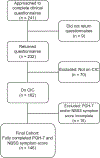Quality of Life and Bladder Symptoms in Adolescents and Young Adults With Spina Bifida Who Catheterize via Urethra vs Catheterizable Channel
- PMID: 38701236
- PMCID: PMC11233230
- DOI: 10.1097/JU.0000000000004013
Quality of Life and Bladder Symptoms in Adolescents and Young Adults With Spina Bifida Who Catheterize via Urethra vs Catheterizable Channel
Abstract
Purpose: We sought to assess associations between health-related quality of life (QOL), bladder-related QOL, bladder symptoms, and bladder catheterization route among adolescents and young adults with spina bifida.
Materials and methods: Clinical questionnaires administered to individuals ≥ 12 years old requiring catheterization between June 2019 to March 2020 in a spina bifida center were retrospectively analyzed. Questionnaires were completed in English or Spanish independently or with caregiver assistance. Medical records were reviewed for demographic and clinical characteristics. Primary exposure was catheterization route (urethra or channel). Primary outcome was health-related QOL, measured by Patient-Reported Outcomes Measurement Information System Pediatric Global Health 7 (PGH-7). Secondary outcomes were bladder-related QOL and bladder symptoms, measured by Neurogenic Bladder Symptom Score (NBSS). Nested, multivariable linear regression models assessed associations between catheterization route and questionnaire scores.
Results: Of 162 patients requiring catheterization, 146 completed both the PGH-7 and NBSS and were included. Seventy-three percent were catheterized via urethra and 27% via channel. Median age was 17.5 years (range 12-31), 58% of patients were female, and 80% had myelomeningocele. Urinary incontinence was more common among those who catheterized via urethra (60%) compared to channel (33%). On adjusted analyses, catheterization route was not significantly associated with PGH-7 or NBSS bladder-related QOL scores. More bladder symptoms were associated with worse bladder-related QOL. Patients who catheterized via channel had fewer bladder symptoms than those who catheterized via urethra.
Conclusions: Catheterization route was not significantly associated with QOL. Though catheterization via channel was associated with fewer bladder symptoms, only degree of current bladder symptoms was significantly associated with bladder-related QOL.
Keywords: neurogenic bladder; quality of life; spina bifida; spinal dysraphism.
Conflict of interest statement
Figures
Comment in
-
Editorial Comment.J Urol. 2024 Aug;212(2):370-371. doi: 10.1097/JU.0000000000004043. Epub 2024 May 20. J Urol. 2024. PMID: 38768154 No abstract available.
-
Editorial Comment.J Urol. 2024 Aug;212(2):369-370. doi: 10.1097/JU.0000000000004046. Epub 2024 May 30. J Urol. 2024. PMID: 38813880 No abstract available.
References
Publication types
MeSH terms
Grants and funding
LinkOut - more resources
Full Text Sources
Medical


